Realisme/Naturalisme
1 like4,262 views
1 of 13
Downloaded 92 times

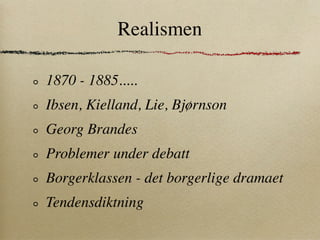
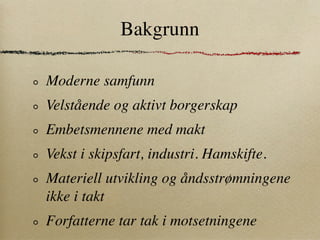
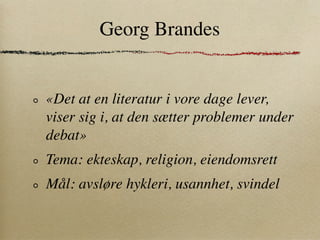

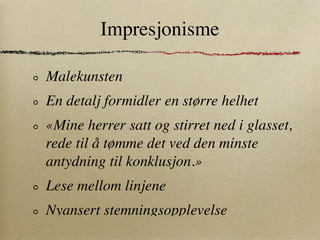
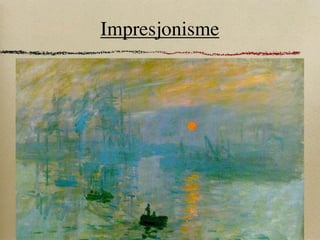

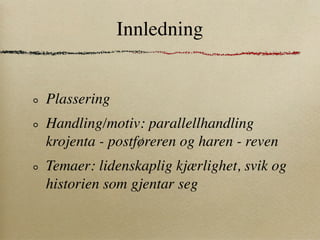
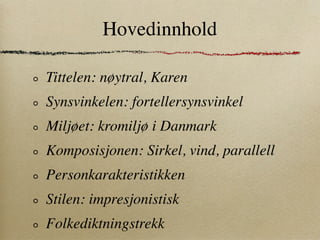
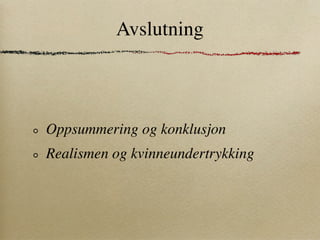
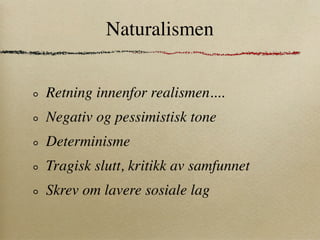
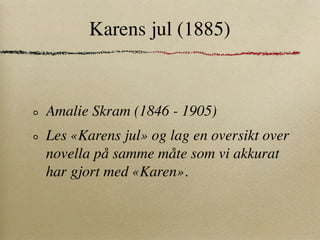
Ad
Recommended
Survey of Poetry
Survey of Poetry wendlingk
╠²
This document provides a concise summary of 1000 years of English poetry in 3 sentences:
Old English poetry from 500-1100 AD used alliteration and was focused on religion, history, and epic tales like Beowulf. Medieval poetry from 1100-1500 AD was influenced by the church and included works like The Canterbury Tales by Chaucer and Sir Gawain and the Green Knight. Renaissance poetry from 1500-1700 AD saw the rise of sonnets, including Petrarchan, Spenserian, and Shakespearean forms, as well as major works like Paradise Lost by Milton.Joyce s ulysses
Joyce s ulyssesBissox
╠²
1) Joyce's Ulysses is structured as 18 episodes that parallel episodes in Homer's Odyssey, with Leopold Bloom and Stephen Dedalus standing in for Odysseus and Telemachus.
2) It uses interior monologue and stream-of-consciousness to follow the wanderings and thoughts of Bloom and Dedalus over the course of a single day in Dublin, recording their impressions, memories, and fantasies.
3) By attempting to simulate human consciousness and bridge the modern world with the classical, Ulysses employs a wide range of styles and serves as an encyclopedic novel that references the whole history of Western culture.Percy bysshe shelley
Percy bysshe shelleyAmanda Ehrhardt
╠²
Percy Bysshe Shelley (1792-1822) was an English Romantic poet who had unorthodox views for his time including atheism, free love, and vegetarianism. He was expelled from Oxford for publishing an atheist pamphlet. Some of his most famous works include the poems Ozymandias, Prometheus Unbound, and Queen Mab as well as the essays A Defence of Poetry and The Necessity of Atheism. Though he died young by drowning, Shelley is considered one of the major English Romantic poets and his works often dealt with themes of political and intellectual freedom.William Blake
William BlakeEmisha Ravani
╠²
William Blake was an English poet, painter, and printmaker from 1757 to 1827 during the Romantic era. Some of his most notable works include Songs of Innocence and of Experience, The Marriage of Heaven and Hell, and Jerusalem. Blake was a visionary artist who created illuminated printing, a technique that combined text and images which he used to publish many of his poems.ELIZABETHAN PERIOD
ELIZABETHAN PERIODHezron Daba
╠²
This document summarizes the Elizabethan period in England and the characteristics of Elizabethan literature. It discusses Queen Elizabeth I's life and reign, noting that England prospered in the latter half and witnessed great playwrights, poets, and scholars. It then characterizes Elizabethan literature, highlighting the revival of interest in Greek works, abundant literary output, rise of new romanticism, translations, spirit of independence, development of drama and popularity of poetry, as well as advances in prose and the emergence of the novel. The Elizabethan age was considered one of the golden ages of English literature.Shakespeare sonnet 1
Shakespeare sonnet 1 Auris Ávila
╠²
The document analyzes Shakespeare's Sonnet 1. It begins by summarizing the premise of the first quatrain, that beautiful creatures should reproduce to preserve beauty. It then analyzes each line and quatrain, explaining that the second quatrain chides the subject for being too self-absorbed and not thinking of procreation. The third quatrain argues his beauty will fade without passing it on. The couplet asks him to reproduce or be like the grave that consumes beauty owed to the world. The analysis provides context, stating Sonnet 1 opens the larger sequence and mini-sequence of procreation sonnets.Style in Shakespeare and Chaucer
Style in Shakespeare and Chaucer Daya Vaghani
╠²
Geoffrey Chaucer and William Shakespeare both lived in England and wrote in English, though they were separated by about 200 years. While Chaucer used repetition primarily for instructional purposes and left some imagery open to interpretation, Shakespeare employed repetition and more detailed imagery to set moods and characterize figures in his works. Both drew from classical Greek and Roman literature in their writing, though Shakespeare combined these sources with modern style.William Shakespeare Presentation
William Shakespeare Presentationsamanthacundill
╠²
This document provides an overview of William Shakespeare's life and career. It discusses that he started seeing plays at a young age and taught himself to read and write before becoming a glove maker. He later joined The Lord Chamberlain's Men acting troupe in London and wrote most of his famous plays for them. The document also summarizes Shakespeare's body of work, including his plays divided into tragedies, comedies, and histories as well as his sonnets. It concludes with Shakespeare retiring to Stratford-upon-Avon and his lasting impact on literature.Tess of the d'Urbervilles
Tess of the d'Urbervillesmjrodger
╠²
The group analyzed passages from Tess of the D'Urbervilles that depict Tess's journey from innocence to experience. They focused on Hardy's use of language and literary devices to explore this theme. Some of the main findings were:
- Hardy uses natural imagery and symbolism to reflect changes in Tess's innocence and purity.
- Religious references and allusions to the Bible show how Tess loses her faith and morality as she experiences hardships.
- Descriptions of the agricultural setting and Tess's work reflect her loss of innocence as she takes on adult responsibilities.
- Seasonal changes parallel transformationsOliver Goldsmith oldsmith & Sheridan
Oliver Goldsmith oldsmith & Sheridan Pina Gondaliya
╠²
This document provides information about Richard Sheridan and Oliver Goldsmith. It summarizes Sheridan's career as a playwright, politician, and owner of the Drury Lane theatre in London. It notes some of his most famous plays, including The Rivals and The School for Scandal. For Goldsmith, it outlines his background and works, including the novel The Vicar of Wakefield, the play She Stoops to Conquer, and the poem The Traveller. The document also lists many of the writings of both authors.PAPER-2 TYPES OF COMEDY
PAPER-2 TYPES OF COMEDYpoojagohil30
╠²
This document provides an overview of different types of comedy. It discusses romantic comedy, comedy of humour, comedy of manners, black comedy, and sentimental comedy. Romantic comedy is a popular form that combines comic and tragic elements with realistic depictions. Comedy of humour focuses on exaggerating particular human passions or follies through stock characters. Comedy of manners satirizes manners and behavior of the upper classes through settings like clubs and coffee houses. Black comedy questions moral values and presents life as a tragic force. Sentimental comedy aims to present moral sentiments but feels unrealistic and lacks appeal.Reality and Sincerity.pptx
Reality and Sincerity.pptxDhatriParmar
╠²
This document summarizes and analyzes several poems by various authors. It discusses F.R. Leavis's approach to literary criticism and analyzes poems by Alexander Smith, Emily Bronte, and Thomas Hardy. For Hardy's poem "After a Journey," it notes that the poem depicts Hardy trying to find his late wife Emma through memories and coming to terms with her death, showing the elements of reality and sincerity in grappling with his real-life experience in a moving tribute. The document evaluates Hardy's poem as the most effective of those discussed in highlighting reality and sincerity through its intimate depiction of Hardy's personal loss.The Rime Of The Ancient Mariner
The Rime Of The Ancient Mariner Jayita Sanapathi
╠²
This document provides a summary and analysis of Samuel Taylor Coleridge's poem "The Rime of the Ancient Mariner." It includes an author biography noting Coleridge was a founder of the English Romantic movement. The poem tells the story of an ancient mariner who is cursed after killing an albatross. Over several stanzas, the document analyzes the mariner's experiences at sea and how he becomes haunted by the dead sailors until blessing some snakes allows his curse to lift. It also mentions literary devices like alliteration and imagery used in the classic poem.John dryden
John drydenOxana Turcanu
╠²
John Dryden (1631-1700) was an influential English poet, literary critic, translator and playwright during the Restoration period in England. He dominated English literature during this time. He was made Poet Laureate in 1668. Dryden established himself as the leading poet and critic after the Restoration. He wrote plays, poems, literary criticisms and translations that made classical works more accessible to English readers. Dryden made major contributions to English literature and language as one of the most important writers of his era.Gulliver's travels
Gulliver's travelsSakina Macadadaya Said
╠²
This document provides a summary of Jonathan Swift's novel Gulliver's Travels. It discusses that the novel is both a satire of human nature and a parody of travel tales. It provides background on Swift and describes the plots and characters of the novel. Key points include Gulliver encountering societies of tiny Lilliputians, giant Brobdingnagians, intellectual yet irrational Laputans, and rational horses. Through these encounters, Gulliver comes to reject human society.The merchant of venice
The merchant of veniceMaria Teresa Ciaffaroni
╠²
The document provides an introduction and plot summary for Shakespeare's play "The Merchant of Venice". It discusses the main characters including Antonio, Bassanio, Portia, Shylock, and Jessica. It also analyzes themes in the play such as love, friendship, family relationships, women's condition at the time, racism, and the contrast between Venice and Belmont. The summary highlights that the play explores complex issues of identity, prejudice, and mercy through the story of a moneylending deal that goes wrong.Modernist poetry
Modernist poetryBissox
╠²
This document provides an overview of modernism as an artistic movement that began after 1910 across various art forms like literature, music, visual arts and film. It discusses some of the key modernist artists and poets like Joyce, Woolf, Eliot, Picasso and discusses common modernist elements like experimentation, representing the unconscious, and subjective reality. It then focuses on modernist poetry, discussing fragmented styles, international influences, and poets like Yeats and Pound. It provides biographical details and analyses of key works for Eliot and discusses his poem The Waste Land as a seminal modernist work.William blake biography
William blake biographyrj_rajon
╠²
William Blake was an English writer and artist born in 1757 who is regarded as an influential figure of the Romantic era. He worked as an engraver but was also a poet and painter. Blake experienced visions throughout his life that influenced his unique works. Though his poetry received little attention during his lifetime and he was seen as strange, he is now recognized for works like Songs of Innocence and Songs of Experience that illustrated the contrary states of the human soul. Blake lived a simple life in London where he died in 1827 at the age of 69 from an illness caused by the fumes of his engraving process.Power point charles dickens
Power point charles dickensaumatell
╠²
Charles Dickens was a famous Victorian author born in 1812 in England. He came from a poor family and had to work in a factory as a child after his father was jailed. Dickens went on to have a very successful career as a writer and journalist. He is best known for his novels such as Oliver Twist, A Christmas Carol, and Nicholas Nickleby which criticized social issues and injustice during the Victorian era. Dickens produced a vast amount of writing in his lifetime before dying in 1870.English drama
English dramaGaby LLaneza
╠²
This document provides an overview of English drama from the Middle Ages to the Restoration period. It summarizes that medieval drama originated from church rituals and evolved into mystery, miracle and morality plays focused on religious themes. Elizabethan drama flourished in public theaters and featured the works of Marlowe, Jonson and Shakespeare. Restoration drama after 1660 saw the return of theaters and the rise of comedy, with authors like Dryden and Congreve writing in different genres and styles.The Victorian Age
The Victorian AgeMustafa ÛNDER
╠²
The Victorian Age from 1830-1901 saw immense changes in England due to industrialization and the growth of cities. While industrialization created wealth for some, it also led to poor working conditions and poverty for many. Queen Victoria came to symbolize the moral values of the period such as domesticity, though there was also evidence of social problems. Literature reflected both the promise and challenges of this time of rapid transition and change in English society.Realism and naturalism
Realism and naturalismAbdel-Fattah Adel
╠²
This document discusses realism and naturalism in literature. It defines realism as aiming for truthful representation of reality, while naturalism takes realism further by emulating scientific methods. Key characteristics of these movements are descriptive detail, contemporary subjects, and colloquial language. The document examines major figures like George Eliot, ├ēmile Zola, and Henry James, outlining their works and theories on realism and naturalism.The age of milton 1625 1660 cholan
The age of milton 1625 1660 cholanvijichola
╠²
The document provides background information on the English Revolution and Restoration period in multiple sections:
1) It outlines the social background of the weakening relationship between the monarchy and bourgeois, and clashes between the King and Parliament that led to the outbreak of the English Revolution.
2) It summarizes the reigns of English monarchs from James I to William III and the Glorious Revolution of 1688.
3) It describes how the English Revolution was carried out under a religious cloak of Puritanism, which aimed to reform manners and liberate man, condemning worldly pleasures.
4) It discusses the literature of the period, including works by John Milton, the MetaphysBallad
BalladDipti Vaghela
╠²
The document discusses the origin and characteristics of ballads. It states that ballads derive from medieval French dance songs and were a form of popular poetry and song in Britain and Ireland from the late medieval period to the 19th century. Ballads tell simple narrative stories in short stanzas and were passed down orally at first before being written. They typically feature themes of love, violence, the supernatural and historical figures and are characterized by their singable nature, universal themes, and use of everyday language.The rape of the lock
The rape of the lockCrowder College
╠²
The document summarizes Alexander Pope's poem "The Rape of the Lock". It describes Pope's life and works before discussing the structure and themes of "The Rape of the Lock". Specifically, it notes that the poem is a mock epic that treats a trivial card game dispute between two families in a dignified and exaggerated style, similar to real epic poems. It also outlines some of the main characters and events in the poem, such as Belinda's sleeping and preparation, the card game where the lock is cut, and the resulting dispute between the families.Aestheticism and romanticism
Aestheticism and romanticismsakinaay
╠²
Aestheticism is an intellectual and art movement that emphasizes aesthetic values over social or political themes in literature, art, music, and other arts. The slogan "art for art's sake" comes from the Decadent movement and figures like Th├®ophile Gautier. Key figures in Aestheticism include Walter Pater, Oscar Wilde, John Keats, Percy Bysshe Shelley, and members of the Pre-Raphaelite Brotherhood like Dante Rossetti and Edward Burne-Jones.Great expectations
Great expectationsž». ┘ģžŁ┘ģž» žŻž©┘łž¦┘ä┘Ŗž│ž▒
╠²
Pip is the protagonist and narrator of Great Expectations. As a child, he meets the wealthy but eccentric Miss Havisham and her adopted daughter Estella. Pip falls in love with Estella but she treats him coldly. Later, Pip receives a mysterious fortune and moves to London to become a gentleman. He learns that the source of his fortune was actually a convict named Magwitch, not Miss Havisham as he had assumed. The novel follows Pip's personal growth and development as he matures and comes to understand the complex social hierarchies and characters that shaped his early life and expectations.Det moderne gjennombrotet elevpresentasjon
Det moderne gjennombrotet elevpresentasjonmettek
╠²
Norsk, litteraturhistorie 1870-1890, realisme, det moderne gjennombruddetMore Related Content
What's hot (20)
William Shakespeare Presentation
William Shakespeare Presentationsamanthacundill
╠²
This document provides an overview of William Shakespeare's life and career. It discusses that he started seeing plays at a young age and taught himself to read and write before becoming a glove maker. He later joined The Lord Chamberlain's Men acting troupe in London and wrote most of his famous plays for them. The document also summarizes Shakespeare's body of work, including his plays divided into tragedies, comedies, and histories as well as his sonnets. It concludes with Shakespeare retiring to Stratford-upon-Avon and his lasting impact on literature.Tess of the d'Urbervilles
Tess of the d'Urbervillesmjrodger
╠²
The group analyzed passages from Tess of the D'Urbervilles that depict Tess's journey from innocence to experience. They focused on Hardy's use of language and literary devices to explore this theme. Some of the main findings were:
- Hardy uses natural imagery and symbolism to reflect changes in Tess's innocence and purity.
- Religious references and allusions to the Bible show how Tess loses her faith and morality as she experiences hardships.
- Descriptions of the agricultural setting and Tess's work reflect her loss of innocence as she takes on adult responsibilities.
- Seasonal changes parallel transformationsOliver Goldsmith oldsmith & Sheridan
Oliver Goldsmith oldsmith & Sheridan Pina Gondaliya
╠²
This document provides information about Richard Sheridan and Oliver Goldsmith. It summarizes Sheridan's career as a playwright, politician, and owner of the Drury Lane theatre in London. It notes some of his most famous plays, including The Rivals and The School for Scandal. For Goldsmith, it outlines his background and works, including the novel The Vicar of Wakefield, the play She Stoops to Conquer, and the poem The Traveller. The document also lists many of the writings of both authors.PAPER-2 TYPES OF COMEDY
PAPER-2 TYPES OF COMEDYpoojagohil30
╠²
This document provides an overview of different types of comedy. It discusses romantic comedy, comedy of humour, comedy of manners, black comedy, and sentimental comedy. Romantic comedy is a popular form that combines comic and tragic elements with realistic depictions. Comedy of humour focuses on exaggerating particular human passions or follies through stock characters. Comedy of manners satirizes manners and behavior of the upper classes through settings like clubs and coffee houses. Black comedy questions moral values and presents life as a tragic force. Sentimental comedy aims to present moral sentiments but feels unrealistic and lacks appeal.Reality and Sincerity.pptx
Reality and Sincerity.pptxDhatriParmar
╠²
This document summarizes and analyzes several poems by various authors. It discusses F.R. Leavis's approach to literary criticism and analyzes poems by Alexander Smith, Emily Bronte, and Thomas Hardy. For Hardy's poem "After a Journey," it notes that the poem depicts Hardy trying to find his late wife Emma through memories and coming to terms with her death, showing the elements of reality and sincerity in grappling with his real-life experience in a moving tribute. The document evaluates Hardy's poem as the most effective of those discussed in highlighting reality and sincerity through its intimate depiction of Hardy's personal loss.The Rime Of The Ancient Mariner
The Rime Of The Ancient Mariner Jayita Sanapathi
╠²
This document provides a summary and analysis of Samuel Taylor Coleridge's poem "The Rime of the Ancient Mariner." It includes an author biography noting Coleridge was a founder of the English Romantic movement. The poem tells the story of an ancient mariner who is cursed after killing an albatross. Over several stanzas, the document analyzes the mariner's experiences at sea and how he becomes haunted by the dead sailors until blessing some snakes allows his curse to lift. It also mentions literary devices like alliteration and imagery used in the classic poem.John dryden
John drydenOxana Turcanu
╠²
John Dryden (1631-1700) was an influential English poet, literary critic, translator and playwright during the Restoration period in England. He dominated English literature during this time. He was made Poet Laureate in 1668. Dryden established himself as the leading poet and critic after the Restoration. He wrote plays, poems, literary criticisms and translations that made classical works more accessible to English readers. Dryden made major contributions to English literature and language as one of the most important writers of his era.Gulliver's travels
Gulliver's travelsSakina Macadadaya Said
╠²
This document provides a summary of Jonathan Swift's novel Gulliver's Travels. It discusses that the novel is both a satire of human nature and a parody of travel tales. It provides background on Swift and describes the plots and characters of the novel. Key points include Gulliver encountering societies of tiny Lilliputians, giant Brobdingnagians, intellectual yet irrational Laputans, and rational horses. Through these encounters, Gulliver comes to reject human society.The merchant of venice
The merchant of veniceMaria Teresa Ciaffaroni
╠²
The document provides an introduction and plot summary for Shakespeare's play "The Merchant of Venice". It discusses the main characters including Antonio, Bassanio, Portia, Shylock, and Jessica. It also analyzes themes in the play such as love, friendship, family relationships, women's condition at the time, racism, and the contrast between Venice and Belmont. The summary highlights that the play explores complex issues of identity, prejudice, and mercy through the story of a moneylending deal that goes wrong.Modernist poetry
Modernist poetryBissox
╠²
This document provides an overview of modernism as an artistic movement that began after 1910 across various art forms like literature, music, visual arts and film. It discusses some of the key modernist artists and poets like Joyce, Woolf, Eliot, Picasso and discusses common modernist elements like experimentation, representing the unconscious, and subjective reality. It then focuses on modernist poetry, discussing fragmented styles, international influences, and poets like Yeats and Pound. It provides biographical details and analyses of key works for Eliot and discusses his poem The Waste Land as a seminal modernist work.William blake biography
William blake biographyrj_rajon
╠²
William Blake was an English writer and artist born in 1757 who is regarded as an influential figure of the Romantic era. He worked as an engraver but was also a poet and painter. Blake experienced visions throughout his life that influenced his unique works. Though his poetry received little attention during his lifetime and he was seen as strange, he is now recognized for works like Songs of Innocence and Songs of Experience that illustrated the contrary states of the human soul. Blake lived a simple life in London where he died in 1827 at the age of 69 from an illness caused by the fumes of his engraving process.Power point charles dickens
Power point charles dickensaumatell
╠²
Charles Dickens was a famous Victorian author born in 1812 in England. He came from a poor family and had to work in a factory as a child after his father was jailed. Dickens went on to have a very successful career as a writer and journalist. He is best known for his novels such as Oliver Twist, A Christmas Carol, and Nicholas Nickleby which criticized social issues and injustice during the Victorian era. Dickens produced a vast amount of writing in his lifetime before dying in 1870.English drama
English dramaGaby LLaneza
╠²
This document provides an overview of English drama from the Middle Ages to the Restoration period. It summarizes that medieval drama originated from church rituals and evolved into mystery, miracle and morality plays focused on religious themes. Elizabethan drama flourished in public theaters and featured the works of Marlowe, Jonson and Shakespeare. Restoration drama after 1660 saw the return of theaters and the rise of comedy, with authors like Dryden and Congreve writing in different genres and styles.The Victorian Age
The Victorian AgeMustafa ÛNDER
╠²
The Victorian Age from 1830-1901 saw immense changes in England due to industrialization and the growth of cities. While industrialization created wealth for some, it also led to poor working conditions and poverty for many. Queen Victoria came to symbolize the moral values of the period such as domesticity, though there was also evidence of social problems. Literature reflected both the promise and challenges of this time of rapid transition and change in English society.Realism and naturalism
Realism and naturalismAbdel-Fattah Adel
╠²
This document discusses realism and naturalism in literature. It defines realism as aiming for truthful representation of reality, while naturalism takes realism further by emulating scientific methods. Key characteristics of these movements are descriptive detail, contemporary subjects, and colloquial language. The document examines major figures like George Eliot, ├ēmile Zola, and Henry James, outlining their works and theories on realism and naturalism.The age of milton 1625 1660 cholan
The age of milton 1625 1660 cholanvijichola
╠²
The document provides background information on the English Revolution and Restoration period in multiple sections:
1) It outlines the social background of the weakening relationship between the monarchy and bourgeois, and clashes between the King and Parliament that led to the outbreak of the English Revolution.
2) It summarizes the reigns of English monarchs from James I to William III and the Glorious Revolution of 1688.
3) It describes how the English Revolution was carried out under a religious cloak of Puritanism, which aimed to reform manners and liberate man, condemning worldly pleasures.
4) It discusses the literature of the period, including works by John Milton, the MetaphysBallad
BalladDipti Vaghela
╠²
The document discusses the origin and characteristics of ballads. It states that ballads derive from medieval French dance songs and were a form of popular poetry and song in Britain and Ireland from the late medieval period to the 19th century. Ballads tell simple narrative stories in short stanzas and were passed down orally at first before being written. They typically feature themes of love, violence, the supernatural and historical figures and are characterized by their singable nature, universal themes, and use of everyday language.The rape of the lock
The rape of the lockCrowder College
╠²
The document summarizes Alexander Pope's poem "The Rape of the Lock". It describes Pope's life and works before discussing the structure and themes of "The Rape of the Lock". Specifically, it notes that the poem is a mock epic that treats a trivial card game dispute between two families in a dignified and exaggerated style, similar to real epic poems. It also outlines some of the main characters and events in the poem, such as Belinda's sleeping and preparation, the card game where the lock is cut, and the resulting dispute between the families.Aestheticism and romanticism
Aestheticism and romanticismsakinaay
╠²
Aestheticism is an intellectual and art movement that emphasizes aesthetic values over social or political themes in literature, art, music, and other arts. The slogan "art for art's sake" comes from the Decadent movement and figures like Th├®ophile Gautier. Key figures in Aestheticism include Walter Pater, Oscar Wilde, John Keats, Percy Bysshe Shelley, and members of the Pre-Raphaelite Brotherhood like Dante Rossetti and Edward Burne-Jones.Great expectations
Great expectationsž». ┘ģžŁ┘ģž» žŻž©┘łž¦┘ä┘Ŗž│ž▒
╠²
Pip is the protagonist and narrator of Great Expectations. As a child, he meets the wealthy but eccentric Miss Havisham and her adopted daughter Estella. Pip falls in love with Estella but she treats him coldly. Later, Pip receives a mysterious fortune and moves to London to become a gentleman. He learns that the source of his fortune was actually a convict named Magwitch, not Miss Havisham as he had assumed. The novel follows Pip's personal growth and development as he matures and comes to understand the complex social hierarchies and characters that shaped his early life and expectations.Similar to Realisme/Naturalisme (20)
Det moderne gjennombrotet elevpresentasjon
Det moderne gjennombrotet elevpresentasjonmettek
╠²
Norsk, litteraturhistorie 1870-1890, realisme, det moderne gjennombruddetForfatterne og den realistiske romanen
Forfatterne og den realistiske romanenmettek
╠²
det moderne gjennombrudd, de fire store, romansjanger, kjennetegn, 1850-1890Litteraturen fra 1900 til 1945
Litteraturen fra 1900 til 1945mettek
╠²
Litteraturhistorie, nyrealisme, kulturkamp, 1900-1945, SignaturKulturkamp i mellomkrigstiden
Kulturkamp i mellomkrigstidenmettek
╠²
Litteraturhistorie, norsk, 1900-tallet, mellomkrigstid, de r├Ėde 30-├źraFordypningsoppgave h├Ėst 2010
Fordypningsoppgave h├Ėst 2010trinem
╠²
Tips fra en bibliotekar til b├Ėker og tema som kan passe til fordypningsoppgaven i norsk p├ź vg3Ad
Realisme/Naturalisme
- 1. Realismen og naturalismen Karen X 2 Anja Andersen, norsk vg3
- 2. Realismen 1870 - 1885..... Ibsen, Kielland, Lie, Bj├Ėrnson Georg Brandes Problemer under debatt Borgerklassen - det borgerlige dramaet Tendensdiktning
- 3. Bakgrunn Moderne samfunn Velst├źende og aktivt borgerskap Embetsmennene med makt Vekst i skipsfart, industri. Hamskifte. Materiell utvikling og ├źndsstr├Ėmningene ikke i takt Forfatterne tar tak i motsetningene
- 4. Georg Brandes ┬½Det at en literatur i vore dage lever, viser sig i, at den s├”tter problemer under debat┬╗ Tema: ekteskap, religion, eiendomsrett M├źl: avsl├Ėre hykleri, usannhet, svindel
- 5. Alexander Kielland (1849 - 1906) Karen, 1882 Viktig begrep; impresjonisme
- 6. Impresjonisme Malekunsten En detalj formidler en st├Ėrre helhet ┬½Mine herrer satt og stirret ned i glasset, rede til ├ź t├Ėmme det ved den minste antydning til konklusjon.┬╗ Lese mellom linjene Nyansert stemningsopplevelse
- 8. Oppgaver Hva handler ┬½Karen┬╗ om? Hvilke temaer tar novella opp? Budskap? Finn eksempler p├ź impresjonisme.
- 9. Innledning Plassering Handling/motiv: parallellhandling krojenta - postf├Ėreren og haren - reven Temaer: lidenskaplig kj├”rlighet, svik og historien som gjentar seg
- 10. Hovedinnhold Tittelen: n├Ėytral, Karen Synsvinkelen: fortellersynsvinkel Milj├Ėet: kromilj├Ė i Danmark Komposisjonen: Sirkel, vind, parallell Personkarakteristikken Stilen: impresjonistisk Folkediktningstrekk
- 11. Avslutning Oppsummering og konklusjon Realismen og kvinneundertrykking
- 12. Naturalismen Retning innenfor realismen.... Negativ og pessimistisk tone Determinisme Tragisk slutt, kritikk av samfunnet Skrev om lavere sosiale lag
- 13. Karens jul (1885) Amalie Skram (1846 - 1905) Les ┬½Karens jul┬╗ og lag en oversikt over novella p├ź samme m├źte som vi akkurat har gjort med ┬½Karen┬╗.
